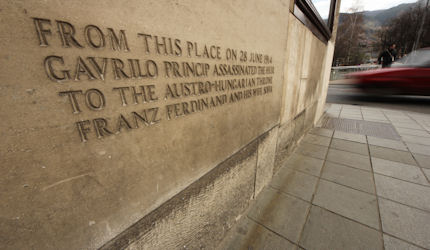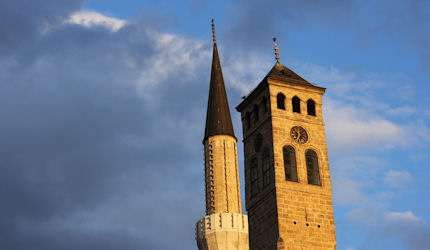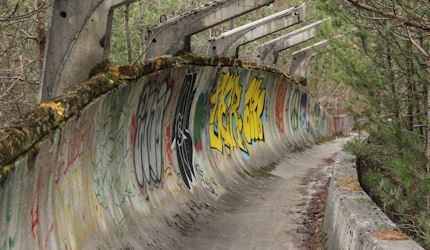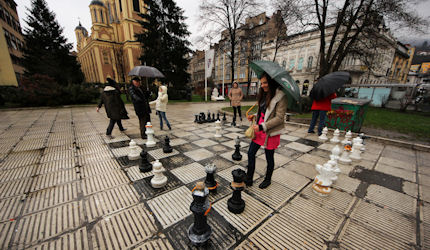How the world changed forever in Sarajevo
It’s nearly a century since events in Sarajevo changed the course of history. Gavin Haines learns more in the Bosnia and Herzegovina capital, a city defined for better and worse, by its tumultuous past.
100 years ago, down this very street, Gavrilo Princip held a smoking gun. Moments earlier, in a violent act of nationalism, the Bosnian Serb had assassinated the heir to the Austro-Hungarian throne, Archduke Franz Ferdinand, and his wife, Sophie.
His motive was political; like many of his countrymen, Princip wanted freedom from the shackles of Austrian rule. Unlike his fellow countrymen, he made it happen.
But his actions on that fateful day, 28 June 1914, also triggered a conflict that changed the destiny of humanity; smarting from the assassination of Franz Ferdinand, Austria-Hungary invaded Serbia the following month. WWI had begun.
Today, the coffee shop from which Princip emerged to shoot Ferdinand is the Museum of Sarajevo. Instead of hot beverages, it serves up the history of Sarajevo between 1878 and 1914; a brief but eventful period, during which Bosnia and Herzegovina was ceded by the Ottoman Empire, conquered by Austria-Hungary and consumed by WWI.
 A plaque marks the spot where Franz Ferdinand was shot
A plaque marks the spot where Franz Ferdinand was shotGavin Haines
A cultural crossroads
Looking around the city’s streets, you could be forgiven for thinking the Great War had not long ended; buildings are riddled with bullet holes and pavements bear the chilling marks of mortar blasts. In a poignant memorial to the victims, the authorities have filled in these blast marks with red wax.
"It represents the blood of the people killed by mortars," explains my guide, Samra. "We call them Sarajevo Roses."
But these memorials aren't from WWI; they are a legacy of the Bosnian War (1992-1995), during which the city of Sarajevo was shelled by Serbian forces for more than 1,000 days. They call it the Siege of Sarajevo and it was the longest siege in modern history, claiming thousands of lives and obliterating the city.
Since those dark days, Sarajevo – a nominee for European Capital of Culture 2014 – has come a long way. "Sarajevo is 80% repaired," explains Samra, as we leave the museum behind and head further into the Ottoman-era Old Town.
Wandering along the narrow cobbled streets, which have been largely restored to their 15th-century splendour, we listen as the call to prayer echoes from the minaret of Gazi Husrev-beg Mosque. It's an evocative reminder that we are at a cultural crossroads.
And not just metaphorically; Ferhadija Street is the literal junction between east and west. It is a place where neoclassical architecture from the Austro-Hungarian period meets Islamic structures from the Ottoman era. The contrast is stark.
It’s starker still when you look at what’s behind the facades; in the neoclassical structures it is western retailers peddling their wares, while the more modest Ottoman buildings are home to craft shops, selling anything from copper coffee sets – an essential in any Bosnian household – to vivid Iranian carpets.
 A minaret and clock tower in Old Town Sarajevo
A minaret and clock tower in Old Town SarajevoGavin Haines
The Olympic legacy
After my walking tour, I jump in a taxi and head for the hills. The verdant peaks surrounding Sarajevo offer beautiful panoramas of the city, but these slopes are haunted; not by ghosts, but by Serb forces, who positioned themselves here to bomb the city.
As we drive up winding mountain roads, the taxi driver makes the shape of a gun with his hands and pretends to fire on the city below. "You understand?" he asks, shuddering at the memories. I nod.
The hills were also home to happier times. In 1984, the Winter Olympics were held in Sarajevo and these slopes were alive with competitors, spectators and the world’s media. Vestiges of the Games remain, most famously the bobsleigh run which is where the taxi driver and I part company.
He bids me farewell with a warning not to stray off the paths because of landmines. "Boom," he says. "You understand?" The authorities say the mines have been cleared now, but it’s best to stick to the forest trails. Alternatively, you could do what I do and walk down the abandoned bobsleigh run, which, 30 years ago, was a theatre of sporting history.
 The 1984 Olympic bobsleigh run is now a canvas for street artists
The 1984 Olympic bobsleigh run is now a canvas for street artistsGavin Haines
That’s hard to believe; since then it has been used as target practice by Serb gunmen and, more recently, as a canvas for Sarajevo’s brilliant street artists. Today the run attracts walkers, photographers and twitchers, who use its lofty position to watch birds; on my walk down I spot jays, woodpeckers and raptors circling on thermals above.
Through the trees I also spot Sarajevo’s only skyscraper, glistening in the sun. Opened in 2008, the Avaz Twist Tower is the headquarters of the Dnevni Avaz newspaper group and my pocket guide says there’s a bar at the top. I’m sold.
The walk to the tower is long, taking me through the charming, hillside suburb of Bistrik, along the banks of the Miljacka River and past a group of young Sarajevans, playing a game of giant chess under the watchful eye of an elderly mentor.
I soon find myself wandering past the Holiday Inn, a gregarious yellow building that hosted the world’s war reporters during the Bosnian War. The hotel is located along 'sniper alley', a nickname given to Vojvode Putnika Street during the conflict. Many innocent civilians were killed by snipers here – most were just trying to get to work. The horror is hard to comprehend.
Eventually I arrive at the Avaz Twist Tower and head up to the smoky sky bar for a pint of the local poison, Sarajevska Pivara. It’s a lively joint with a young crowd, who consume alarming quantities of cigarettes and bucketloads of coffee.
From my bar stool I watch as the Balkan breeze blows away the cloud to reveal a sweeping panorama of the city; I head out to the viewing platform for better views and watch as Sarajevo basks in the setting sun.
Below me, trams meander around the streets, trees sway in the breeze and terracotta roofs glow in the day’s final rays. The city is peaceful; peaceful and pretty. And at that moment, it’s hard to believe it was ever anything but.
 Locals brave the elements to play chess in the street
Locals brave the elements to play chess in the streetGavin Haines
Need to know
There are no direct flights to Sarajevo from the UK. Croatia Airlines (www.croaticairlines.com) fly via Zagreb and Austrian Airlines (www.austrian.com) go via Vienna. For more information about Sarajevo visit www.sarajevo-tourism.com.
Do you have any Feedback about this page?
© 2025 Columbus Travel Media Ltd. All rights reserved. No part of this site may be reproduced without our written permission, click here for information on Columbus Content Solutions.









 You know where
You know where